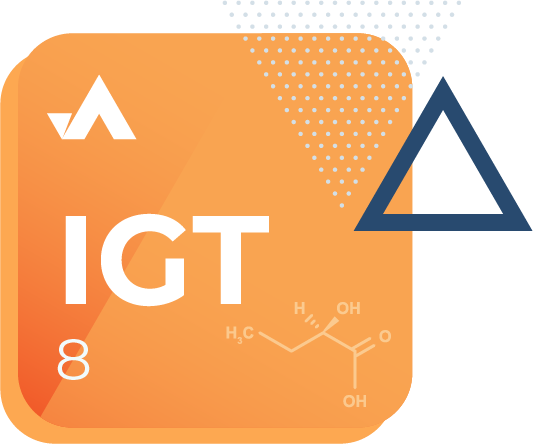
Metabolon Target
Impaired Glucose Tolerance Targeted Panel
8 Metabolites
Absolute Quantitation
Rigorous Quality Control
End-to-end Service
About Impaired Glucose Tolerance
Impaired Glucose Tolerance is a prediabetic state of hyperglycemia that is associated with insulin resistance and an increased risk of cardiovascular disease.1 The condition occurs when blood glucose levels remain high for an extended period after oral ingestion of glucose but are not high enough to be diagnosed as type 2 diabetes. Impaired Glucose Tolerance can be assessed with a single fasted blood draw by measuring a panel of selected metabolites comprised of two small organic acids (α-hydroxybutyric acid (AHB) and 4-methyl-2-oxopentanoic acid (4MOP)), two lipids (oleic acid and linoleoyl glycerophosphocholine (LGPC)), a ketone body (β-hydroxybutyric acid (BHBA)), an amino acid (serine), a vitamin (pantothenic acid (vitamin B5)), and glucose.2
Metabolomics reveals biological insights otherwise unseen. For a successful metabolomics study, both small molecule discovery and the ability to dig deeper into specific biomarkers of interest are needed to uncover actionable insights that propel new therapeutic developments. A specific combination of liquid chromatography-mass spectrometry (LC-MS) technology and biochemical expertise is required to identify these biomarkers of interest and develop assays that are sensitive enough to explore them fully.
At Metabolon, we understand the crucial role glucose tolerance plays in diabetes, and we’ve established best-in-class expertise to assess this condition. This panel focuses on specific metabolites and their pathways that impact glucose tolerance. This panel can be used to track biomarkers and enhance biological understanding across preclinical and clinical research.
Impaired Glucose Tolerance Targeted Panel Details
Swipe left/right to view the full table.
| LLOQ* | |
|---|---|
| Metabolite | EDTA Plasma |
| Serine | 2.50 µg/mL |
| 2-Hydroxybutyric acid | 0.500 µg/mL |
| 4-Methyl-2-oxopentanoic acid | 0.500 µg/mL |
| Oleic acid | 10.0 µg/mL |
| LGPC | 2.50 µg/mL |
| 3-Hydroxybutyric acid | 1.00 µg/mL |
| Pantothenate | 0.0100 µg/mL |
| Glucose | 10 mg/dL |
*Lower Limit of Quantitation (LLOQ) varies for each sample type.
Analysis Method and Instrumentation:
LC-MS/MS (Agilent 1290 UHPLC/Sciex QTrap 5500)
| Sample Type and Required Amounts | |
|---|---|
| Sample Type | Sample Requirements |
| Fasting EDTA Plasma | 0.5 mL |
Others on request.
This panel is for Research Use Only and is not to be used for diagnostic purposes.
Delivering Absolute Quantification for Research and Biomarker Analysis
Our readily available or custom developed quantitative assays help you achieve your research and biomarker validation objectives with precise and fully validated methods. Our targeted assays and panels cover >1,000 metabolites and lipids across a wide range of biochemical classes, metabolic pathways, and physiological processes, and they can be customized to best fit any application.
Impaired Glucose Tolerance Targeted Panel Applications
Diabetes
Diabetes is a serious metabolic condition affecting more than 37 million Americans and 460 million people worldwide according to the most recent report from the Centers for Disease Control. Despite being a worldwide epidemic, much remains unknown about individual risk factors for diabetes development, and research is currently being done to identify new and effective treatments for diabetes at all stages. By facilitating the assessment of specific metabolic pathways impacted by diabetes, targeted metabolomics can be a critical tool used to identify biomarkers of disease development for early intervention and novel targets to control disease progression, as well for the development of new pharmaceuticals with specific mechanisms of action.


Cancer
Cardiovascular Diseases

Big Insights with Metabolon
Cited in over 3,000 publications, we help scientists and manufacturers gain greater insight into their studies through metabolomics. See how our approach can become a successful part of your workflow.
Related Metabolomics Resources
Contact Us
Talk with an expert
Request a quote for our services, get more information on sample types and handling procedures, request a letter of support, or submit a question about how metabolomics can advance your research.
Corporate Headquarters
617 Davis Drive, Suite 100
Morrisville, NC 27560
Mailing Address:
P.O. Box 110407
Research Triangle Park, NC 27709
References
1. Barr EL, Zimmet PZ, Welborn TA, et al. Risk of cardiovascular and all-cause mortality in individuals with diabetes mellitus, impaired fasting glucose, and impaired glucose tolerance: the Australian Diabetes, Obesity, and Lifestyle Study (AusDiab). Circulation. 2007;116(2):151-157. doi:10.1161/CIRCULATIONAHA.106.685628
2. Cobb J, Eckhart A, Perichon R, et al. A novel test for IGT utilizing metabolite markers of glucose tolerance. J Diabetes Sci Technol. 2015;9(1):69-76. doi:10.1177/1932296814553622
3. Hills SA, Balkau B, Coppack SW, et al. The EGIR-RISC STUDY (The European group for the study of insulin resistance: relationship between insulin sensitivity and cardiovascular disease risk): I. Methodology and objectives. Diabetologia. 2004;47(3):566-570. doi:10.1007/s00125-004-1335-5
4. American Diabetes Associate Standards of Medical Care in Diabetes – 2015. Diabetes Care. 2015; 38(Sup 1):S8-S16




